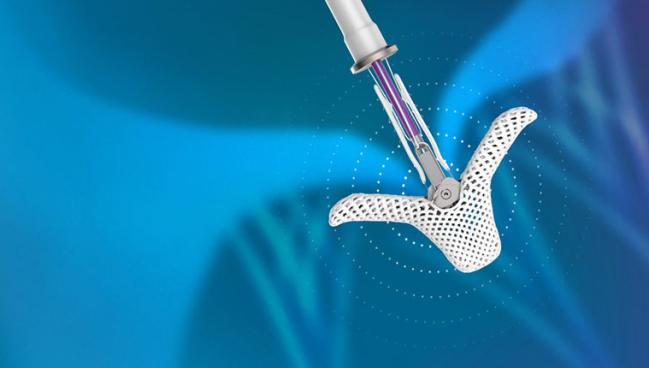FDA Advisors Set to Take on TriClip for TR as TRILUMINATE Questions Loom
The executive summary questions the open-label trial, noting that benefit was driven by a softer QoL endpoint.

Photo Credit: Abbott
The US Food and Drug Administration’s Circulatory System Devices Panel is set to decide the regulatory fate of the TriClip G4 (Abbott Medical) next week, and briefing documents released today suggest the agency’s panel will have their work cut out for them.
Based on the TRILUMINATE pivotal trial, the device manufacturer is requesting TriClip be approved for the improvement of health status in patients at intermediate-to-high risk for surgery with symptomatic severe tricuspid regurgitation (TR) despite being treated with optimal medical therapy.
Even though TRILUMINATE met its primary endpoint, the agency reviewers seem to have raised several issues in an executive summary that they would like the FDA advisory panel to discuss, chief among them the finding that the benefit of tricuspid edge-to-edge repair (TEER) with TriClip was driven by improvements in quality of life, a softer clinical endpoint.
TriClip was designated a breakthrough device by the FDA, but the agency states that while this program allows sponsors to use “efficient and flexible clinical study designs,” that doesn’t lower the bar for approval. “The totality of the data still needs to demonstrate that the device provides a reasonable assurance of safety and effectiveness for its intended population,” according to the FDA reviewers.
Just last week, the FDA took many by surprise when it approved the transcatheter Evoque tricuspid valve replacement system (Edwards Lifesciences) for the treatment of severe TR without convening an advisory committee. That approval was based on results of the TRISCEND II study which showed the device significantly improved TR grade and led to meaningful improvements in functional status and symptoms in patients with severe TR.
Deep Dive Into TRLUMINATE
In their briefing documents, which were published on the FDA’s website ahead of the February 13, 2024, advisory panel meeting, the agency reviewers take a deep dive into the TRILUMINATE study. The randomized, controlled trial of TriClip plus optimal medical therapy (OMT) versus OMT alone in 350 patients with symptomatic severe TR also included a single-arm cohort of patients eligible for the trial, but who had a low likelihood that TR would be reduced to moderate or less.
Full results of TRILUMINATE were presented last year at the American College of Cardiology Scientific Sessions and published simultaneously in the New England Journal of Medicine. In the study, the hierarchical composite endpoint favored TEER at 1 year. There were no differences between the TEER and control groups in freedom from all-cause death/tricuspid valve surgery or freedom from hospitalization for heart failure (HF), but the improvement in the Kansas City Cardiomyopathy Questionnaire (KCCQ) overall summary score was significantly better with TriClip.
Given that TRILUMINATE was an unblinded, open-label trial, the FDA reviewers point out that patient-reported outcomes such as the KCCQ score “could be subject to the placebo effect,” and given that the primary endpoint improvement was driven by improvement in quality of life, they want the advisory panel to discuss the relative benefit of treatment.
They also note that the “win ratio” result for the primary endpoint was better in sites that enrolled 10 or more patients, a finding that brings into question the generalizability of the results to centers with varying experience. Of the 65 sites that participated in the trial, 56 enrolled fewer than 10 patients and 42 enrolled less than 5 patients. Additionally, while the primary endpoint was met in the intention-to-treat and as-treated populations, it was not met in the per-protocol analysis, the reviewers write.
Finally, the FDA reviewers want the advisory panel to weigh the significance of additional findings, namely the numerically higher rates of all-cause mortality, cardiovascular mortality, HF hospitalization, tricuspid valve interventions, major bleeding, and new-onset renal failure seen with TriClip. The panel is also expected to parse data from the single-arm cohort and determine what value it may add to the randomized trial results.
The Circulatory System Devices Panel, which is chaired by Richard Lange, MD (Texas Tech University Health Sciences Center, El Paso), is a fully virtual meeting. The panel are being asked by the FDA to vote on whether there is reasonable assurance of safety and effectiveness for using TriClip in patients who meet the proposed indication. They will also vote on whether the benefits outweigh the risks in appropriate patients. While the FDA does not have to follow the recommendations of the advisory panel, they frequently do.
TriClip has been available in Europe since 2020, when it gained CE Mark approval.
Michael O’Riordan is the Managing Editor for TCTMD. He completed his undergraduate degrees at Queen’s University in Kingston, ON, and…
Read Full BioSources
US Food and Drug Administration. Executive summary: Premarket application for TriClip G4 system. Published and accessed on February 9, 2024.





Comments